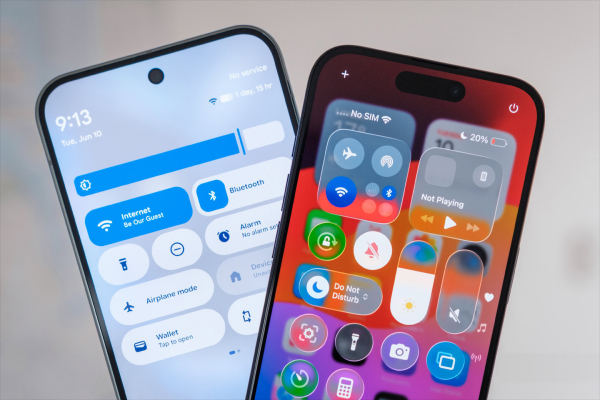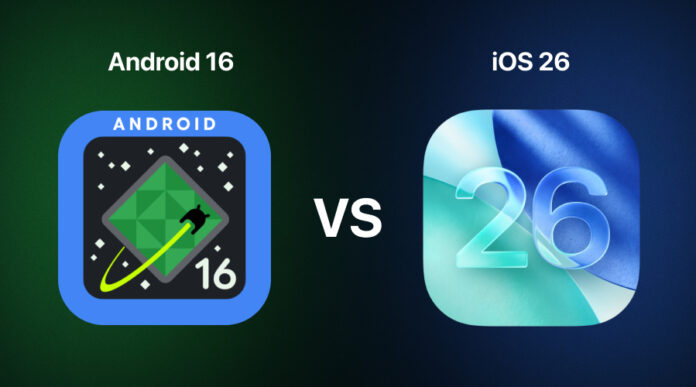Well, hello there, fellow tech enthusiast! It’s that time of year again—the digital battleground is heating up, and in the respective corners, we have two titans of the mobile world: Google’s Android 16 and Apple’s iOS 26. As we hurtle towards the latter half of 2025, the annual refresh of our beloved mobile operating systems is upon us. And let me tell you, this year, the changes are more than just skin deep. We’re talking about some serious AI-powered smarts, slick new designs, and features that will genuinely make your life easier.
So, grab a comfy seat and your beverage of choice, because we’re about to dive deep into what makes these two updates tick. Forget the dry, robotic spec sheets; we’re going to have a real conversation about how these changes will impact your daily life, from your morning scroll to your late-night video editing sessions.
The First Impression: A Tale of Two Redesigns
You know that feeling when you walk into a redecorated room and everything just feels… better? That’s the vibe both Android 16 and iOS 26 are going for this year, but they’re taking distinctly different paths to get there.
Android 16 is all about “Material You” on steroids, with a new design language Google is calling “Material 3 Expressive.” If you thought your Pixel already looked good, get ready for a whole new level of personalization. Think more fluid animations, bolder color palettes that adapt to your wallpaper, and a notification shade that’s finally getting the smart grouping it has deserved for years. No more endless stream of notifications from one app; they’ll now be neatly bundled up. It’s the little things, right?
On the other side of the fence, iOS 26 is introducing a stunning visual overhaul dubbed “Liquid Glass.” Inspired by the aesthetics of visionOS, Apple is bringing a sense of depth and translucency to the iPhone. Icons have a new 3D, glassy effect, and menus float with a satisfying responsiveness. It’s a design that feels both futuristic and incredibly intuitive. Imagine your phone’s interface having the same satisfying feel as a well-crafted glass object. It’s a subtle shift, but one that makes the whole experience feel more premium.
The Takeaway: Both operating systems are doubling down on aesthetics, but in their own signature styles. Android is all about vibrant, personal expression, while iOS is chasing a sleek, almost ethereal look.
The AI Revolution: Your Phone is Now Your Genius Assistant
If there’s one overarching theme for both Android 16 and iOS 26, it’s the deep, meaningful integration of Artificial Intelligence. We’re moving beyond the novelty of AI-powered photo filters and into an era where our phones anticipate our needs.

Google, with its deep roots in AI, is pushing the boundaries of what on-device processing can do. This means faster, more private AI features that don’t need to send your data to the cloud for every little task. Think a Google Assistant that can hold a more natural, multi-turn conversation, understanding the context of your requests without you having to repeat yourself.
One area where I’m personally excited to see this in action is with creative tools. Imagine you’ve just come back from a weekend trip and have a bunch of video clips. In the past, editing them into something shareable could be a chore. Now, with the advanced AI in Android 16, you can expect to see more powerful and intuitive video editing features baked right in. For example, a video background remover could become a standard feature in the native gallery app. Picture this: you’re trying to create a cool, cinematic video, but the background of your clip is cluttered and distracting. With a simple tap, the AI could intelligently isolate the subject and let you swap in a more dynamic backdrop. No need for complex software or a powerful computer.
Apple, not to be outdone, is introducing “Apple Intelligence.” Their focus, as always, is on privacy and a seamless user experience. A significant portion of their AI processing will happen directly on your iPhone, ensuring your personal data stays personal. Siri is getting a major upgrade, becoming more contextually aware and capable of taking actions within apps.
This push for on-device intelligence also has exciting implications for creative professionals and hobbyists. Many of us who dabble in video creation have a trusty mac video editor that we rely on. With the advancements in iOS 26, we can expect the creative experience across apple devices whether you’re on an iPhone, iPad or Mac to feel more unified than ever. Imagine being able to start a project on your iPhone, using AI to quickly remove a bland background from a video clip, and then seamlessly picking it up on your Mac for more detailed edits. The line between mobile and desktop workflows is becoming increasingly blurred, and that’s a win for creators everywhere.
The Takeaway: Both platforms are getting a serious brain boost. Google’s AI feels a bit more utilitarian and deeply integrated with its services, while Apple’s is focused on a polished, private, and creatively empowering experience.
Features That Will Actually Change Your Day
Beyond the flashy redesigns and the powerful AI, what are the practical, day-to-day features that will make a real difference?
For Android 16, the focus seems to be on refining the user experience and adding some clever quality-of-life improvements. The improved notification system is a big one, but there are also whispers of a more robust “Focus Mode” to help you disconnect, and deeper integration with other devices in the Android ecosystem.
iOS 26, on the other hand, is bringing some long-awaited features that are sure to please its user base. We’re finally getting more customizable lock screen widgets and the ability to place app icons wherever we want on the home screen. It might sound like a small thing, but for those of us who have been clamoring for more personalization on iOS, this is a huge deal.
A Personal Story: I remember a few years back, trying to edit a short video for a friend’s birthday on my phone. The process was so clunky and frustrating that I almost gave up. The idea that in 2025, I could have a powerful video background remover at my fingertips, right on my phone, is mind-boggling. It’s a testament to how quickly this technology is evolving and becoming accessible to everyone.
The Verdict: Which Upgrade is Right for You?
So, who wins the battle of Android 16 vs. iOS 26? The honest answer is… it depends on what you value most.
If you’re an Android user, you’re getting a more intelligent, more personalized, and more expressive operating system than ever before. The advancements in on-device AI and the continued refinement of the Material You design language make Android 16 a compelling upgrade.
If you’re in the Apple ecosystem, iOS 26 is a significant leap forward in terms of both aesthetics and intelligence. The new “Liquid Glass” design is stunning, and the introduction of “Apple Intelligence” brings a new level of smarts to the iPhone without compromising on privacy. The improved synergy between your iPhone and your mac video editor is also a major plus for creatives.
Ultimately, both operating systems are becoming more intuitive, more powerful, and more helpful. And that’s a win for all of us. This year, the choice between Android and iOS is less about which one is “better” and more about which flavor of innovation you prefer. And with features like advanced video editing tools becoming commonplace, the creative potential in our pockets has never been greater.
What are your thoughts on the upcoming updates? Are you team Android or team iOS? Let’s continue the conversation in the comments below!

